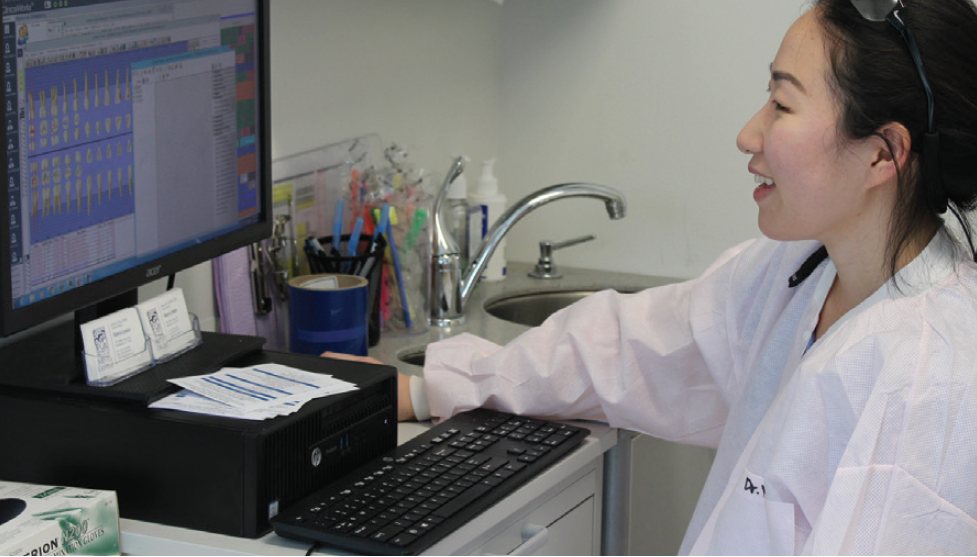
Making a difference: Dr. Jessica Yoo at work at Mary’s Center, a community health center in Washington, D.C.
When it comes to the early detection of eating disorders, dentists are in a unique position for spotting the early warning signs and referring patients to the proper behavioral health professionals.
 According to the National Eating Disorders Association, more than 10 million Americans currently are affected by serious eating disorders such as anorexia, bulimia and binge eating. These disorders can develop or re-emerge at any age, regardless of gender, shape or size. They can also adversely impact a person’s oral health, which NEDA estimates affect 89 percent of bulimic patients.
According to the National Eating Disorders Association, more than 10 million Americans currently are affected by serious eating disorders such as anorexia, bulimia and binge eating. These disorders can develop or re-emerge at any age, regardless of gender, shape or size. They can also adversely impact a person’s oral health, which NEDA estimates affect 89 percent of bulimic patients.
Dr. Jessica Yoo, a dentist working at a community health center in Washington, D.C., said listening is often the best tool when first approaching a patient who may be suffering from an eating disorder.
“Some patients may not even realize they need help,” she said. “Dentists are in a great position to detect the early signs and symptoms of eating disorders and even help the patients recognize the eating disorder. I try to help by listing the clinical findings such as eroded enamel, exposed dentinal layer, caries, trauma on hard palate due to self-induced gag reflex, angular cheilitis, halitosis, etc., so the patients can understand what is going on with their oral health and I answer any questions they may have.”
Oral signs a patient could be suffering from an eating disorder include:
• Loss of tissue and lesions on the teeth.
• Changes in the color, shape and length of teeth.
• Increased tooth sensitivity or decay.
• Enlargement of the salivary glands, dry mouth and reddened, dry, cracked lips.
Dr. Yoo added, “Patients who have symptoms or see change in their teeth are open to discuss about their oral health, possibly more readily than discussing their behavioral pattern. I think having any medical professional starting a discussion on eating disorders is a great first step for them.”
Dr. Yoo said she first encountered a patient with an eating disorder as a student at the Temple University Kornberg School of Dentistry. One of her first patients was a part-time model who suffered from bulimia nervosa — a condition NEDA defines as “a serious, potentially life-threatening eating disorder characterized by a cycle of bingeing and compensatory behaviors such as self-induced vomiting.” She spent most of her clinical years in school following up with the patient. The two women later became friends, and helping patients with eating disorders sparked a personal passion in the new dentist.
“In trying to help her as much as I can. I started talking to professors from multiple disciplines, including restorative dentistry and endodontics to a behavioral health science
professor. We also had multiple lectures on the early detection of eating disorder, which helped me correctly diagnose and direct the conversation toward it.”
After graduation, Dr. Yoo joined Mary’s Center, a community health center whose mission is “to build better futures through the delivery of health care, education and social services.” She was introduced to the organization by Dr. Richard Gesker, the former chief dental officer at the facility.
When approaching a patient, Dr. Yoo also stressed the importance of making sure they are comfortable talking about his or her condition and urged providers to consider all risk factors — from the social, demographic and psychiatric perspective — when making their assessment. At the federally qualified health center where she works, she can refer patients to medical, behavioral and nutritional health specialists but when that’s not available, she recommended they find local therapists or clinics that treat patients with eating disorders and make sure the patient gets multidisciplinary help in assessing their nutritional, psychological and medical status.
In 2017, Drs. Gesker and Yoo participated in a Capitol Hill briefing on behalf of the ADA.
The briefing, which the Eating Disorders Coalition facilitated, discussed the importance of early detection of eating disorders and stressed the necessity for Congress to fund the 21st Century Cures Act, which aims to accelerate the discovery, development and delivery of new cures and treatments in the way the nation treats disease.

Great article. Thanks
http://dhc.dental/cosmetic-dentist-in-miami/
Pingback: Can Dentists Spot Eating Disorders? | Dental Patient News
This article will help people to prevent such type of common dental health issue. Keep sharing this type of information. Thanks!
Thanks for sharing, appreciate you, Drs. Gesker and Yoo.
http://dentistnashvilletn.org/
For me, this is not a new concept. What is also not new is the following: Unless deemed a service of medical necessity, reimbursement for the often complex and comprehensive oral health care servcies often needed to make these patient whole will go wanting. Until ‘dental’ is replaced by the mantle of Oral Medicine and Stomatology, and is viewed and accepted by its practitioners, confreres, and the health-care industry at large, as a sub-specialty within the disciplines of ENT/Head and Neck Medicine ,the patient will continue to receive short shrift.
Arnold Rosenstock MSEd DDS
Clinical Associate Professor, NYU [Ret’d]